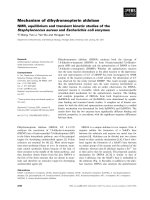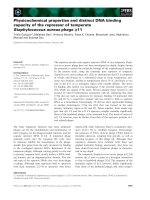Methicillin-Susceptible and Methicillin-resistant staphylococcus aureus from the retail meat shops and customers
Bạn đang xem bản rút gọn của tài liệu. Xem và tải ngay bản đầy đủ của tài liệu tại đây (418.45 KB, 11 trang )
Int.J.Curr.Microbiol.App.Sci (2019) 8(4): 1929-1939
International Journal of Current Microbiology and Applied Sciences
ISSN: 2319-7706 Volume 8 Number 04 (2019)
Journal homepage:
Original Research Article
/>
Methicillin-Susceptible and Methicillin-Resistant Staphylococcus aureus
from the Retail Meat Shops and Customers
Asima Zehra*, Maliha Gulzar, Randhir Singh and Simranpreet Kaur
1
School of Public Health and Zoonoses, Guru Angad Dev Veterinary and Animal Sciences
University (GADVASU), Ludhiana-141004, Punjab, India
*Corresponding author
ABSTRACT
Keywords
Staphylococcus
aureus, Multidrug
resistance,
Epsilometer test,
MRSA, BORSA,
Swab
Article Info
Accepted:
15 March 2019
Available Online:
10 April 2019
This study was completed to know the prevalence of Methicillin-Susceptible (MSSA) and
Methicillin-Resistant S. aureus (MRSA) in swab samples from retail meat shops (RM) and
customers (CU) in five districts of Punjab, India. An aggregate of 182 swabs samples was
aseptically collected from RM shops and customers. The collected samples were processed
for an isolation of S. aureus isolates. The phenotypic resistance of S. aureus isolates was
most noteworthy to Penicillin (PEN, 97.83%) trailed by Ciprofloxacin (CPH, 56.52%),
Tetracycline (TET, 36.96%), Trimethoprim-Sulfamethoxazole (TSH, 34.78%) and
Erythromycin (ERY, 17.39%). However, low resistance was observed to Clindamycin,
Chloramphenicol, Oxacillin, Ceftriaxone, and that fluctuated from 2%-7%. None of the
isolates was phenotypically resistant to vancomycin (MIC 0.5-2 µg/ml). A large portion of
S. aureus isolates (58.69%, 95% CI 43.63-61.93) were Multi-drug resistant (MDR) and
carried resistant genes to penicillin (blaZ), oxacillin (mecA), gentamicin (aacA-aphD),
erythromycin (ermB, ermC) and tetracycline (tetK, tetM). Two S. aureus isolates were
borderline oxacillin resistant (BORSA) with MIC 4 µg/ml and one isolate was MRSA
(Oxacillin MIC 16 µg/ml) with a genotypic profile, mecA+blaZ+aacA-aphD+tetK+ermC+.
Among the erythromycin-resistant or intermediate resistant isolates, none expressed
inducible macrolide lincosamide and streptogramin (MLSB) phenotype (ERY+/CLI-, D+)
except for one MSSA isolates from CU hand swab sample that demonstrated a constitutive
MLSB phenotype (Erm+/Cli+, D-).
Introduction
Antibiotic resistance and its exchange to
different microorganisms are turning into a
rising and serious pattern in developing
countries like India. Community related
sources are one such source that are
imperative in harboring and dissemination of
drug resistant microorganisms like S. aureus.
S. aureus is universal in nature and ordinarily
present on the skin and mucous membrane of
animal and human, in soil and water (Irlinger
2008). It is likewise an imperative food-borne
pathogen (Morgan 2008). In spite of the fact
1929
Int.J.Curr.Microbiol.App.Sci (2019) 8(4): 1929-1939
that it could be found in other animal and
environment, a human is the noteworthy
reservoir for S. aureus (Moellering, 2006). S.
aureus resistance to oxacillin carrying mecA
gene, presently known as MRSA, was first
reported in the year 1961 and from that point
forward it has been reported in isolates from
hospitals, food, animals, community and
environment (Ogata et al., 2012). MRSA
isolates have been recognized in people in the
community who do not have the conventional
risk factors for S. aureus infection.
The CA-MRSA infections are of specific
general wellbeing concern since they result in
serious infections including necrotizing
fasciitis and necrotizing pneumonia. The high
morbidity, mortality, and cost of care related
with organism features the requirement for
public health agencies, hospitals, and other
research facilities to precisely recognize these
microorganisms.
Before, the development of MRSA infection
was for all intents and purposes constrained to
individuals who had history of ongoing
hospitalization. Other than its presence in
hospital environment, MRSA has likewise
been reported from community settings
(Roberts et al., 2011). MRSA has been
isolated from understudy homes, university
campus and public transportation system in
the community (Roberts et al., 2011).
The development of antibiotic resistance in
India is a major issue as antibiotic resistance
particularly MRSA has been reported from
hospitals in India (INSAR 2013, Nadig et al.,
2012, D’Souza et al., 2010). However,
antibiotic resistance of S. aureus isolates from
retail meat shops and customers has not been
pursued aggressively, particularly in Punjab.
Consequently, the point of this study was to
determine the prevalence, MRSA and
futrthermore characterize AR pattern of S.
aureus phenotypically and genotypically.
Materials and Methods
Collection of samples
A total of 182 swab samples from retail meat
shops and customers were collected for the
isolation of S. aureus from 5 districts of
Punjab, India. Swab samples from retail meat
shops (RM) included samples from chopping
block (34), butcher’s hand (37), and chopping
knife (38). Region wise collection of different
swab samples in the present study is given in
Table 1. Swabs were transported back to the
laboratory on ice and handled for isolation of
S. aureus within 6 hours of collection.
Isolation and identification of S. aureus
Isolation of S. aureus from the swab samples
was endeavored according to method
suggested by Bacteriological Analytical
Manual 2012 (Bennett and Lancette, 2001)
after making necessary modifications
according to Zehra et al., 2017. Colonies with
typical morphology were then exposed to
Gram staining and catalase test. Gram and
catalase positive isolates were biochemically
recognized as S. aureus utilizing the
HiStaphTM Identification Kit (HiMedia Labs,
Mumbai). These S. aureus isolates were
purified and maintained in 20% (v/v) glycerol
at -20°C.
Antibiotic susceptibility testing of S. aureus
isolates
The antibiotic susceptibility testing (AST) of
S. aureus isolates was performed by the
Epsilometer test (E-test, Figure 1). All the S.
aureus isolates were tested for their
affectability to different antibiotics viz.
Oxacillin,
Penicillin,
Tetracycline,
Chloramphenicol, Co-trimazole, Ceftriaxone,
Gentamicin, Erythromycin, Ciprofloxacin,
and Vancomycin using Ezy MICTM strip
(HiMedia Lab, Mumbai). AST for
1930
Int.J.Curr.Microbiol.App.Sci (2019) 8(4): 1929-1939
amoxicillin/clavulinic acid (β-lactamases
hyperproduction) and D-test (inducible
clindamycin resistance) was performed by
disc diffusion method according to CLSI
guidelines (M100-S21).
2017) and Saha et al., 2008, respectively.
However, cycling condition for coa and blaZ
was as per the methodology of Zehra et al.,
(2017).
Statistical analysis
Identification of antibiotic-resistant genes
All the S. aureus isolates were likewise
screened for the presence of following
antibiotic resistance genes: blaZ, mecA,
aacA-aphD, erm (ermA, ermB, ermC), tet
(efflux genes tetK and tetL, tetM and tetO of
the ribosomal protection (RP) family) and
vanA encoding for Penicillin, Oxacillin,
Gentamicin, Erythromycin, Tetracycline and
Vancomycin resistance, respectively, by
amplification of the existing gene utilizing
multiplex Polymerase Chain Reaction (PCR)
(Table 1).
A S. aureus strain ATCC 33591 and ATCC
33592 was used as MRSA (mecA +ve) and
MSSA (mecA -ve) positive control,
respectively.
KU872013,
KP834338/
KP834339,
KP658721,
KP658723,
KP886833, KT454736, KT454737, S. aureus
isolates were used as positive control for
genes blaZ, aacA-aphD, tetK, tetL, tetM,
ermB, ermC, respectively.
The isolation of genomic DNA from S.
aureus strains was done using HiPurATM
bacterial genomic DNA purification kit
(HiMedia Lab, Mumbai). Each isolate was
subjected to a separate multiplex PCR assays
for a detection of each group (gp) of genes:
gp1 (16S rDNA, nuc, mecA); gp2 (tetK, tetL,
tetM and tetO); gp3 (ermA, ermB, ermC and
aacA-aphD); gp4 (coa and blaZ) as detailed
in Zehra et al., (2017). Separate PCR was run
for vanA gene. The cycling conditions of
multiplex PCR for gp1, gp2 and gp3 and of
single PCR for vanA gene were as per
methodology of Strommenger et al., 2003
(with little modifications as per Zehra et al.,
Microsoft excel was used for statistical
analysis. The categorical variables were
compared using a Pearson Chi-squared or
Fisher’s exact test, as appropriate. Differences
were considered significant when the P-value
was < 0.05.
Results and Discussion
Prevalence of S. aureus
A total 46 swab samples out of 182 were
positive for S. aureus culturally and affirmed
through genus and species-specific PCR,
resulting in an overall prevalence of 25.27%
(95% CI 15.97-34.57; Table 2, Figure 2).
Among the swab samples from RM shops, S.
aureus was frequently isolated from butcher’s
Knife (47.37%) trailed by butcher’s hand
(45.94%), chopping block (11.76%) and CU
hand (9.6%) (Table 2). The recurrence of S.
aureus isolation from butcher hands and knife
were significantly different (P<0.05) than
from Cu hands. The odds of finding S.
aureus-positive swab samples from RM
workers were at least 2 times higher than the
hand of customers.
These outcomes of the present study feature
the requirement for good hygiene amid
transportation, dealing with at retail outlets
and customers to diminish the risk of
transmission of S. aureus.
Antibiotic resistance of S. aureus
Among 46 S. aureus isolates from various
swab samples, a large portion of the isolates
1931
Int.J.Curr.Microbiol.App.Sci (2019) 8(4): 1929-1939
showed resistance to Penicillin (PEN,
97.83%) trailed by Ciprofloxacin (CPH,
56.52%), Tetracycline (TET, 36.96%),
Trimethoprim-Sulfamethoxazole
(TSH,
34.78%) and Erythromycin (ERY, 17.39%).
Nonetheless, low resistance was seen to
Clindamycin, Chloramphenicol, Oxacillin,
Ceftriaxone, and that varied from 2%-7%
(Table 3). None of the isolates was discovered
resistant to Vancomycin.
Most of the S. aureus isolates (58.69%, 95%
CI 43.63-61.93) in the present study were
resistant to atleast three antibiotics and they
were designated as multidrug-resistant S.
aureus (MDR). S. aureus isolates were
resistant to antibiotics somewhere in the range
0 and 5, with a median of 2 on account of CU
hand swab samples and with a median of 3 on
account of RM swab samples. However, the
quantity of antibiotics to which S. aureus
isolates were resistant did not vary
significantly between swab samples (p>0.05).
Antibiotic resistance gene
S. aureus isolate (1/46=2.17%) was assigned
as MRSA dependent on the presence of
methicillin resistance gene (mecA, Figure 1).
This MRSA isolates was found only in CU
hand swab sample from Gurdaspur district
(0.55%, 1/182) which accounted for 1.37%
(1/73) MRSA prevalence in CU hand swab
samples.
MRSA in the food of animal origin and
community settings represents a significant
risk to human wellbeing. In this study, the CU
hand swab sample was the only sample
contaminated with MRSA. Regardless of
sample size variations, these studies
suggested that MRSA contamination of
various source can change by location due to
the difference in management practices,
hygienic measures and molecular distinction
may exist among MRSA isolates of different
origin.
Isolates that was mecA positive, indicated
resistance to oxacillin (MIC 16 µg/ml).
Nonetheless, two S. aureus (2/46, 4.35%)
isolates that were phenotypically resistant to
oxacillin yet genotypically without mecA had
MIC 4 µg/ml and assigned as Borderline
Oxacillin Resistant S. aureus (BORSA).
Martineau et al., (2000) likewise reported the
presence of isolates that were phenotypically
oxacillin resistant however negative for the
mecA gene. Similarly, Pereira et al., (2009)
found 38% of S. aureus isolates resistant to
oxacillin yet just 0.68% of the isolates
demonstrated the presence of the mecA gene.
Borderline oxacillin-resistant S. aureus
(BORSA) has been frequently observed
phenotype amongst S. aureus isolates. These
isolates are cefoxitin/ceftriaxone susceptible
and do not carry the mecA or mecC genes,
however, are indicated oxacillin resistance
MIC between 1-8 𝜇g/ml (Shore and Coleman
2013). Such pattern may be a direct result of
hyperproduction of β-lactamases, a creation
of typical PBP with modified binding
capacity or variant of mecA gene (Martineau
et al., 2000, Laurent et al., 2012). To bar the
likelihood of hyperproduction of β-lactamase,
amoxyclave antibiotic disk diffusion test was
performed (Martineau et al., 2000). The
results of this study showed that isolates from
RM (oxacillin resistant, mecA negative) to be
ceftriaxone susceptible and β-lactamases
hyperproducers
(blaz+
and
amoxicillin/clavulinic acid disc diffusion size
> 20 mm).
Gentamicin resistant isolates were observed
just in RM swab samples (3/39, 7.69%) with
MIC 16-32 µg/ml. These isolates were
positive for the aacA-aphD gene (Figure 3).
On the other hand, 8.69% (4/46) S. aureus
isolates possessed aacA-aphD gene yet were
phenotypically sensitive to gentamicin. This
might be because of the absence of expression
or partial expression of aac(6′)/aph(2′′) gene
(Martineau et al., 2000, Choi et al., 2003). In
1932
Int.J.Curr.Microbiol.App.Sci (2019) 8(4): 1929-1939
this study, the aacA-aphD gene was found in
MRSA isolates. This Gentamicin-resistant
MRSA is ordinarily experienced in
community isolates and is less as often as
possible found among clinical isolates (Ida et
al., 2001).
In the present study, tetK and tetM genes were
present in S. aureus isolates (Figure 4). Of the
total S. aureus isolates, 36.96% (17/46) were
positive for tetK and 4.35% (2/46) were
positive for both tetK and tetM genes. None of
the isolates were positive for tetL and tetO
gene. An MRSA isolate was positive for the
tetK/tetM gene. The wide circulation of tetK
and tetM among S. aureus and MRSA isolates
have been connected to the way that these
genes are situated on mobile genetic elements
(Chopra and Roberts 2001). Among the
Erythromycin resistant genes, just ermB and
ermC genes were present in S. aureus isolates
(Figure 3). The majority of the S. aureus
isolates that were carrying any of the erm
genes demonstrated complete or intermediate
resistance to Erythromycin.
Table.1 Primers used for detection of antibiotic resistant genes in S. aureus
Gene
Oligonucleotide sequence (5`-3`)
aacA-aphD
TAA TCC AAG AGC AAT AAG GGC
GCC ACA CTA TCA TAA CCA CTA
AAG CGG TAA ACC CCT CTG A
TTC GCA AAT CCC TTC TCA AC
CTATCTGATTGTTGAAGAAGGATT
GTTTACTCTTGGTTTAGGATGAAA
AAT CGT CAA TTC CTG CAT GT
TAA TCG TGG AAT ACG GGT TTG
GTA GCG ACA ATA GGT AAT AGT
GTA GTG ACA ATA AAC CTC CTA
AGT GGA GCG ATT ACA GAA
CAT ATG TCC TGG CGT GTC TA
GTCGTTGCGCGCTATATTCC
GTGAACGGTAGCCCACCTAA
AATGAAGATTCCGACAATTT
CTCATGCGTTGTAGTATTCCA
AAA ATC GAT GGT AAA GGT TGG C
AGT TCT GCA GTA CCG GAT TTG C
ACT TCA ACA CCT GCT GCT TTC
TGA CCA CTT TTA TCA GCA ACC
ATGAATAGAATAAAAGTTGC
TCACCCCTTTAACGCTAATA
CAG CTC GTG TCG TGA GAT GT
AAT CAT TTG TCC CAC CTT CG
ermA
ermB
ermC
tetK
tetM
tetL
tetO
mecA
blaZ
vanA
16SrDNA
(Staphylococcus
genus specific)
Nuc
GCGATTGATGGTGATACGGTT
AGCCAAGCCTTGACGAACTAAAGC
1933
Amplicon
size
227
190
142
299
360
158
696
781
532
173
1032
420
279
Reference
Strommenger
et al., (2003)
Strommenger
et al., (2003)
Martineau et
al., (2000)
Strommenger
et al., (2003)
Strommenger
et al., (2003)
Strommenger
et al., (2003)
Huys et al.,
(2005)
Huys et al.,
(2005)
Strommenger
et al., (2003)
Martineau et
al., (2000)
Saha et al.,
(2008)
Strommenger
et al., (2003)
Brakstad et
al., (1992)
Int.J.Curr.Microbiol.App.Sci (2019) 8(4): 1929-1939
Table.2 Prevalence of S. aureus in RM shops and CU hand samples from different districts of
Punjab
Districts
Butcher Hand
(%)
Ludhiana
Amritsar
Gurdaspur
Patiala
Barnala
Total
4/6
(66.7)
2/5
(40.0)
5/13
(38.46)
3/6
(50.0)
3/7
(42.85)
17/37
(45.94)
Swabs
Chopping
Butcher Knife
block
(%)
(%)
1/5
2/7
(20)
(28.57)
0/6
3/6
(0.0)
(50.0)
3/14
7/13
(21.42)
(53.85)
0/6
3/7
(0)
(42.86)
0/3
2/6
(0.0)
(33.33)
4/34
18/38
(11.76)
(47.37)
Total Swab
samples
(%)
7/18
(38.89)
5/17
(29.41)
15/40
(37.5)
6/19
(31.58)
5/16
(31.25)
39/109
(35.78)
Hand
(Customers)
(%)
1/15
(6.67)
2/16
(12.5)
3/12
(25.0)
0/13
(0)
1/17
(5.89)
7/73
(9.59)
Table.3 Antibiotic resistance of S. aureus isolates isolated from RM shops and CU hand swab
samples
Antibiotic
No. of isolates resistant*(%)
n=46
OXA
PEN
TET
CLI
CTR
GEN
ERY
CPH
TSH
CHL
VAN
2.17
97.83
36.96
2.17
0.00
6.52
17.39
56.52
34.78
4.35
0.00
No. of isolates
resistant from
RM swab
samples1 (%)
n=109
0.00
34.86
15.59
0.00
0.00
2.75
1.83
21.10
14.68
0.00
0.00
No. of isolates
resistant from
CU swab samples
(%)
n=73
1.37
100.00
0.00
1.37
0.00
0.00
8.22
4.11
0.00
2.74
0.00
OXA-oxacillin, PEN-penicillin, TET-tetracycline, CLI-clindamycin, CTR-ceftriaxone, GEN-gentamicin, ERYerythromycin, CPH-ciprofloxacin, TSH-trimethoprim-sulfamethoxazole, CHL-chloramphenicol, VAN-vancomycin.
1-swab samples from hand/knife/chopping block.
*Resistant strains include only those that showed complete resistance
n- no. of isolates under study
Note: For erythromycin resistance estimation only isolates showing complete resistance were consider although 14
other isolates were intermediate resistant.
1934
Int.J.Curr.Microbiol.App.Sci (2019) 8(4): 1929-1939
Fig.1 The Epsilometer test showing the interaction of the inhibition zone with the strip of a S.
aureus for Ceftriaxone (CTR)
Fig.2 Agarose gel electrophoresis of PCR-amplified products using genus (16S rDNA420bp)/species-specific (nuc-279bp) and mecA (532bp) primer sets. lane M, 100-bp Plus DNA
size marker; lane S, S. aureus ATCC 33591 reference strain; lane NTC, no template control
1935
Int.J.Curr.Microbiol.App.Sci (2019) 8(4): 1929-1939
Fig.3 Agarose gel electrophoresis of PCR-amplified products using tetracyline resistance genes
primer sets. Lanes 1-5, examined Staphylococcus aureus isolates; lane M, 100-bp Plus DNA size
marker; lane S, Standard; lane NTC, no template control.
Fig.4 Agarose gel electrophoresis of PCR-amplified products using tetracyline resistance genes
primer sets. Lanes 7-11, examined Staphylococcus aureus isolates; lane M, 100-bp Plus DNA
size marker; lane S, Standard; lane NTC, no template control. Note: Isolate in the lane 9 was
isolates from the meat sample not from swab samples.
1936
Int.J.Curr.Microbiol.App.Sci (2019) 8(4): 1929-1939
Fig.5 D-shaped zone of inhibition around the Clindamycin disk is designated as the D phenotype
which is labeled as D+.
In this study, 19.57% (9/46) of the S. aureus
isolates were genotypically negative yet
demonstrated an intermediate resistance with
MIC
1-2µg/ml
phenotypically.
This
intermediate resistance to Erythromycin could
be because of different genes like msrA or
novel gene ermTR (Seppa¨la¨ et al., 1998,
Martineau et al., 2000). Similarly, Martineau
et al., (2000) additionally reported two S.
aureus isolates resistant to erythromycin
phenotypically however not carrying any of
the erm resistance genes. It was additionally
seen that the isolates from the CU hands were
complete resistant to erythromycin unlike
samples from RM.
These isolates that were resistant (R) or
intermediate resistant (IR) to erythromycin in
vitro tested for inducible clindamycin
resistance (D-test, Figure 5). Among the 22
erythromycin-resistant (R+IR) S. aureus
isolates, none demonstrated inducible MLSB
phenotype (ERY+/CLI-, D+) aside from one
MSSA (methicillin susceptible S. aureus)
isolates from CU hand swab sample that
showed a constitutive MLSB phenotype
(Erm+/Cli+, D-).
In conclusion, this is the short study of the
prevalence of S. aureus and MRSA in RM
and CU hand swab samples from five districts
of Punjab. This study detailed a relatively
high prevalence of S. aureus and high rates of
antimicrobial resistance amongst the isolates.
Just one isolate was MRSA and was isolated
from the hand of the customer. The
information of this study affirm the uneven
conceivable sources of MRSA contamination
in the food chain that can have a potential role
in the dispersal of multidrug-resistant S.
aureus isolates This study clearly shows the
prerequisite of further investigation at the
ranch, retail and customer levels including
large sample size over time so as to all the
more likely evaluate the presence and cause
of MRSA in domesticated animals and the
risk to livestock handlers and costomers in
Punjab.
Practical measures ought to be taken to
guarantee the wellbeing of our food products.
Likewise, the present study uncovered the
prevalence of BORSA that is of public health
concern in light of the fact that the
occurrences of BORSA have been accounted
for in emergency clinics.
Acknowledgement
This work was financially supported at
School of Public Health and Zoonoses,
GADVASU under Rashtriya Krishi Vikas
Yojana (RKVY).
1937
Int.J.Curr.Microbiol.App.Sci (2019) 8(4): 1929-1939
Conflict of interest
The authors declare that they have no
competing interests.
References
Bennett R, and Lancette G. BAM:
Staphylococcus aureus. Fda.gov. 2001;
retrieved from />food/foodscienceresearch/laboratorymet
hods/ucm071429.htm
Choi S M, Kim S H, Kim H J, Lee D G, Choi
J H, Yoo J H, Kang J H, Shin W S,
Kang M W. 2003. Multiplex PCR for
the detection of genes encoding
aminoglycoside modifying enzymes and
methicillin
resistance
among
Staphylococcus species. Journal of
Korean medical Science, 18(5): 631-36.
Chopra I and Roberts M. 2001. Tetracycline
antibiotics:
mode
of
action,
applications, molecular biology, and
epidemiology of bacterial resistance.
Microbiology and Molecular Biology
Reviews 65:232–60.
D’Souza N, Rodrigues C, Mehta A. 2010.
Molecular
characterization
of
methicillin-resistant
Staphylococcus
aureus with emergence of epidemic
clones of sequence type (ST) 22 and ST
772 in Mumbai, India. Journal of
Clinical Microbiology 48: 1806-11.
Ida T, Okamoto R, Shimauchi C, Okubo T,
Kuga A, Inoue M. 2001. Identification
of aminoglycoside-modifying enzymes
by susceptibility testing: epidemiology
of methicillin-resistant Staphylococcus
aureus in Japan. Journal Clinical
Microbiology 39: 3115-21.
Indian Network for Surveillance of
Antimicrobial Resistance (INSAR)
group, India. 2013. Methicillin resistant
Staphylococcus aureus (MRSA) in
India: Prevalence & susceptibility
pattern. Indian Journal of Medical
Research 137: 363-69.
Irlinger F. 2008. Safety assessment of dairy
microorganisms:
Coagulase-negative
staphylococci. International Journal of
Food Microbiology 126: 302-10.
Laurent F, Chardon H, Haenni M, Bes M,
Reverdy M E, Madec J Y, Lagier E,
Vandenesch F, Tristan A. 2012. MRSA
harboring mec A variant gene mecC in
France. Emerging Infectious Disease
18: 1465 – 67.
Martineau F, Picard J F, Lansac N, Menard C,
Roy H P, Ouellette M and Bergeron G
M. 2000. Correlation between the
resistance genotype determined by
multiplex pcr assays and the antibiotic
susceptibility
patterns
of
Staphylococcus
aureus
and
Staphylococcus
epidermidis.
Antimicrobial
Agents
and
Chemotherapy 44(2): 231-38.
Moellering R C. 2006. The Growing Menace
of Community-Acquired Methicillin
Resistant
Staphylococcus
aureus.
Annals of Internal Medicine 144: 36870.
Morgan M. 2008. Methicillin-resistant
Staphylococcus aureus and animals:
Zoonosis or humanosis? The Journal of
Antimicrobial Chemotherapy 62: 118187.
Nadig S, Velusamy N, Lalitha P, Kar S,
Sharma S, and Arakere G. 2012.
Staphylococcus aureus eye infections in
two Indian hospitals: the emergence of
ST772 as a major clone. Clinical
Ophthalmology (Auckland, N.Z.) 6:
165–173
Ogata K, Narimatsu H, Suzuki M, Higuchi W,
Yamamoto T, Taniguchi H. 2012.
Commercially Distributed Meat as a
Potential Vehicle for CommunityAcquired
Methicillin-Resistant
Staphylococcus
aureus.
Applied
Environmental Microbiology 78(8):
2797-2802.
1938
Int.J.Curr.Microbiol.App.Sci (2019) 8(4): 1929-1939
Pereira V, Lopes C, Castro A, Silva J, Gibbs
P
and
Teixeira
P.
2009.
Characterization
for
enterotoxin
production, virulence factors, and
antibiotic
susceptibility
of
Staphylococcus aureus isolates from
various foods in Portugal. Food
Microbiology 26:278–82.
Roberts M C, Soge O O, No D, Helgeson S E
and
Meschke
J
S.
2011.
Characterization of methicillin-resistant
Staphylococcus aureus isolated from
public surfaces on a university campus,
student homes and local community.
Journal of Applied Microbiology 110:
1531-37.
Seppa¨la¨ H, Skurnik M, Soini H, Roberts M
and Huovinen H. 1998. A novel
erythromycin resistance methylase gene
(ermTR) in Streptococcus pyogenes.
Antimicrobial Agents Chemotherapy
42:257–62.
Shore A, and Coleman D. Staphylococcal
cassette chromosome mec: Recent
advances
and
new
insights.
International Journal of Medical
Microbiology 2013; 303(6-7): 350-359.
/>2.002
Strommenger B, Kettlitz C, Werner G and
Witte W. 2003. Multiplex PCR assay
for simultaneous detection of nine
clinically relevant antibiotic resistance
genes in Staphylococcus aureus.
Journal of Clinical Microbiology 41:
4089-94.
Zehra A, Singh R, Kaur S and Gill JPS. 2017.
Molecular characterization of antibioticresistant Staphylococcus aureus from
livestock
(bovine
and
swine).
Veterinary World. 5: 598-604
How to cite this article:
Asima Zehra, Maliha Gulzar, Randhir Singh and Simranpreet Kaur. 2019. MethicillinSusceptible and Methicillin-Resistant Staphylococcus aureus from the Retail Meat Shops and
Customers. Int.J.Curr.Microbiol.App.Sci. 8(04): 1929-1939.
doi: />
1939









